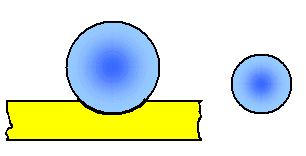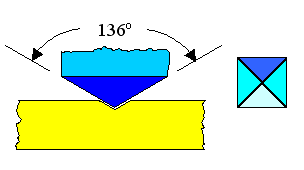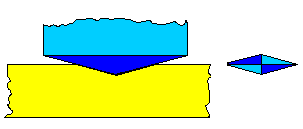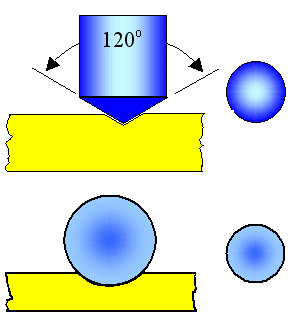|
3.3.2 Ways to Measure Hardness |
 |
When you measure hardness, you press some hard and small object (the indenter)
into the material to be tested with sufficient force to leave a permanent impression. The means that you always deform plastically
or fracture you specimen locally. The "size" of the indentation gives you the hardness number. |
|
 |
Methods differ by the material used for the indenter, its size and geometry,
how you press, and how you measure. |
|
 |
Since hardness plays a big role in sword blade lore, I give you an overview of the various
methods employed. |
|
| |
| |
| Type | Indenter |
Procedure | | |
Description | Geometry |
Shape | |
| Brinell | 10 mm sphere
Variable load |
 |
Hardness number from load, depth and diameter of indentation. |
| Vickers | Diamond pyramid; square base |
 |
Hardness number from load and width of indentation. |
| Knoop | Diamond pyramid; rectangular base |
 |
Hardness number from load and depth of indentation. |
Rockwell
A
C
D | Diamond cone |
 |
Hardness number from fixed load and depth of indentation. |
Rockwell
B
F
G |
1/16 inch
steel sphere |
Rockwell
E
H | 1/8 inch
steel sphere |
|
| |
|
 |
The fact that there are many ways to measure hardness, producing different numbers
for the same specimen, graphically demonstrates that each method has it pros and cons. I won't go into that, however.
As far as steel is concerned, numbers are usually given in either Vickers or Rockwell. With the figure
from before you can easily convert from one scale to the other. |
|
 |
Once more: No hardness test can compete with a tensile test; the latter gives far more information
and numbers useful for calculations. But hardness tests are relatively cheap, easy to do, and in particular applicable to
very small samples and samples with weird shapes. |
 |
Just to put hardness in perspective, the following table gives
the Vickers hardness of some common materials. Note that there are variations for one and the same material not only for
steel but for almost everything. The number given thus must be seen as a typical harness. |
| |
|
|
|
| Metals | Vickers hardness | |
Ceramics | Vickers hardness | | Tin (Sn) |
5 | Limestone | 250 |
| Aluminum (Al) | 25 | Magnesia (MgO) |
500 | | Gold (Au) | 35 |
Window glas | 550 | | Copper (Cu) |
40 | Granite | 850 |
| Pure iron (Fe) | 80 | Quartz (SiO2) |
1200 | | Good tin bronze (Cu + 10% Sn) | 220 |
"China" (Mostly Al2O3) | 2500 |
| Mild steel | 140 | Tungstencarbide (WC) |
2500 | | Hardened steel | 900 |
| |
Polymers | | Polypropylene | 7 | |
Polyvinylchloride (PVC) | 16 | | Polycarbonate |
14 | | Epoxy | 45 |
|
| |
|
© H. Föll (Iron, Steel and Swords script)



